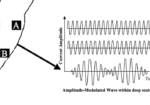Incorporating Emerging Evidence into Clinical Practice for Patients Experiencing Dorsal Wrist Pain During Weight-Bearing Activities
By: Brittany Day
Supporting Evidence
A randomized control study recently published in the Journal of Hand Therapy found rigid carpal stabilizing taping (CST) to significantly increase passive range of motion, active range of motion, and decrease pain in patients experiencing dorsal wrist pain during weight-bearing extension compared to placebo with elastic tape (Kim et al., 2019).
Rationale
Wrist extension takes place at the radiocarpal and midcarpal joint (2 degrees of radiocarpal motion to every 1 degree of midcarpal motion) and occurs as the proximal carpal row rolls dorsally while gliding volarly on the radius which may lead to gapping within the proximal carpal row during end-range movements (Foumani et al., 2009). When weight-bearing in extension, the scaphoid supinates while the lunate pronates effectively spreading the carpal bones further apart limiting extension potential (Kobayashi et al., 1997). The idea behind CST is to restrict the midcarpal joint, scaphoid supination, and lunate pronation to increase wrist extension potential with reduction in pain (Kim et al., 2019).
Who is Right for Carpal Stabilizing Taping?
CST may used for patients with dorsal wrist pain caused by various diagnoses such as:
- Distal Radius Physical Stress Injuries
- Scaphoid Impaction Syndrome
- Dorsal Impingement Syndrome
- Wrist Hypomobility without Ligament Instability
CST may not be appropriate for:
- Allergies to adhesives
- Tenosynovitis
- Dorsal Wrist Ganglion Cyst
- Scapholunate Injury or Instability
- Carpal Tunnel Syndrome
Dorsal impaction hand therapy – How to Apply Tape
- Use rigid athletic tape that is 1-2 cm in width.
- Use a marker to indicate four bony landmarks on the wrist: Dorsal ridge of scaphoid, listers tubercle, triquetrum, pisiform
- Connect the indicated marks with tape circumferentially while patient’s hand is resting at 45 degrees of flexion.

Carpal Stabilizing Taping Intervention Ideas (dorsal wrist impingement exercises)
The following is a list of interventions that may be completed with CST and are a progression from mild to moderate difficulty. Clinical reasoning must be used when progressing patient.
Ball Rolling – Place hand firmly on ball. Roll forward into flexion and back into extension without lifting hand. Complete exercise for 3 minutes.
Tray Balancing – Balance a tray or plate in palm. Hold without dropping for 3 minutes.

Wrist Extension with PowerWeb – Hold PowerWeb in lap or on a table. Press wrist into extension. Hold 10 seconds and repeat 10 times.

Wall Slides with Towel – Begin with towel in hand resting on wall. Shoulder should be flexed over 90 degrees. Slowly lower arm to increase demand on wrist extension. Sustain stretch for ten seconds just before the point of pain is reached. Repeat 10 times.

Wall Push-Ups– Place hands on wall with shoulders at 90 degrees and elbows extended. Complete 3 sets of 10 push-ups on the wall.

References:
Foumani, M., Strackee, S.D., Jonges, R., Blankevoort, L., Zwinderman, A.H., Carelsen, B., & Streekstra, G.J. (2009). In-vivo three-dimensional carpal bone kinematics during flexion–extension and radio–ulnar deviation of the wrist: Dynamic motion versus step-wise static wrist positions. Journal of Biomechanics, 42(16), 2664-2671.
Kim, G., Weon, J., Kim, M., Koh, E., & Jung, D. (2019). Effect of weight-bearing wrist movement with carpal-stabilizing taping on pain and range of motion in subjects with dorsal wrist pain: A randomized controlled trial. Journal of Hand Therapy, 33(1), 25-33.
Kobayashi, M., Berger, R., Nagy, L., Linscheid, R., Uchiyama, S., Ritt, M., & An, K. (1997). Normal kinematics of carpal bones: A three-dimensional analysis of carpal bone motion relative to the radius. Journal of Biomechanics, 30(8), 787-793.
3 Comments
Leave a Comment
More To Read
Taking Alpha-Lipoic Acid for 40 days after Carpal Tunnel Surgery can decrease the likelihood of developing Pillar Pain.
Filippo, B., Granchi, D., Roatti, G., Merlini, L., Sabattini, T., & Baldini, N. (2017). Alpha-lipoic acid after median nerve decompression at the carpal tunnel: A randomized controlled trial. The Journal of Hand Surgery, 4, 236–42. The Skinny – A double-blind, randomized controlled study was performed. Sixty-four patients were randomly assigned into two groups after median…
Read MoreDo you know the secret ingredient to recovering from an injury?
Do you know the secret ingredient to recovering from an injury? I will give you a hint it is 5 letters and begins with the letter S. SLEEP Have you ever asked yourself a question – does sleep help injuries heal? This is for you to share with your patients but also serve as a…
Read MoreThe Role of Sensory Re-education After Nerve Injury
Priya, B. A. (2012). Effectiveness of Sensory Re-education after Nerve Repair (Median or Ulnar Nerve) at the Wrist Level. Indian Journal of Physiotherapy & Occupational Therapy, 6(3), 62–68. The Skinny The human nervous system is incredibly complex and, once damaged, requires significant time to repair. A previous study (Bentzel, K 2002) identifies that with peripheral…
Read MoreIFC vs TENS: Electrical Stimulation for Pain and Swelling
In this article we’re looking at the difference between Inferential Current versus Transcutaneous Electric Nerve Stimulation (IFC vs TENS). Transcutaneous Electric Nerve Stimulation (TENS) TENS variations are often described by their technical characteristics: high frequency, low intensity (conventional TENS) or low frequency, high intensity (acupuncture-like TENS, AL-TENS) (Walsh et al., 2009). How TENS Addresses Pain:…
Read MoreSign-up to Get Updates Straight to Your Inbox!
Sign up with us and we will send you regular blog posts on everything hand therapy, notices every time we upload new videos and tutorials, along with handout, protocols, and other useful information.







Is there a video on finding the bony prominences and application? How much pull (if any) is there to secure it?
It works
I have taped my wrists for years while lifting…Subsequently i have no hair on my wrists..
It limits, to some degree, the combined motion of supination and flexion helping to avoid a TFCC issue while bearing weight
Does this kind of issue/ pain flare up and disappear overnight? Or does it linger?